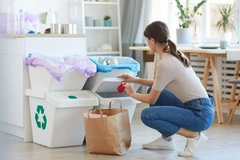Drinktec 2022: Mosca and Gebhardt debut AGVs and strapping tec

16 Aug 2022 --- To demonstrate how automated guided vehicles (AGVs) and strapping machines may function together in a single application, Mosca teamed up with materials handling business Gebhardt Intralogistics. Mosca is also debuting two strapping innovations at Drinktec 2022, in Munich, Germany, that pack fragile bottles securely with maximum protection.
AGVs are load carriers with wheels and computer control that do not need an operator in the vehicle. As there is no human engagement within the vehicle, they are employed to improve workplace safety. Software-based guidance systems, as well as sensor-based guiding systems, control their movement.
Jan Schlichting, sales manager of Mobile Robotics and AGVs at Gebhardt, discusses the potential of the configuration in which AGVs and strapping machines may operate together. “Mosca machines are well-known for high performance. Companies can further exploit this capacity when they combine AGVs and strapping machines in one operation,” he remarks.
The prototype application makes use of a KZV-321 pallet strapping machine, a Mosca Evlution SoniXs MS-6 H with vertical edge protection, and Gebhardt’s Karis automated transport system.
Johannes Wieder, sales manager of Logistics at Mosca, explains that while these two machines demonstrate the full potential of combining AGVs and end-of-line solutions for various products, almost any Mosca machine can be integrated into the application.
The ABCs of AGVs
At the end of the line, AGVs and other contemporary transport systems provide essential flexibility. They are designed to be highly flexible, scalable and room-saving. For example, a business doesn’t necessarily need to develop a new manufacturing line if it wants to boost throughput – instead, it can just increase the number of AGVs.
Autonomous transportation systems are quickly taking off in the industry. According to the company, the deployment of AGVs increased almost twofold between 2013 and 2021.
In contrast to fixed technology, such as conveyors utilizing chains, rollers, or belts, AGVs provide a fundamental advantage: when feeding is flexible, individual machines can operate at maximum capacity – without having to adapt to slower upstream machinery.
Using this stand-alone solution, each product is transported to the device that secures it for transport, which is a strategy that works particularly well for strapping machines.
“Strapping machines often have much higher throughput than upstream machines and can easily process products from several different lines. As a result, high-performance machines only operate at full capacity when they are integrated into flexible lines that use technologies like AGV,” Wieder explains.
Strapping successes
From September 12 to 16 at DrinkTec, Mosca will demonstrate two distinct beverage container security solutions. The KZV-111 pallet strapping machine is the first. It is made for strapping items to pallets and may use vertical strapping to apply the necessary amount of downward force to empty cans.
Additionally, the KZV-111 secures up to 61 pallets per hour for transport, employs sustainable PET strapping composed of 100% recycled materials and conserves resources. The company says that heavy pallets can be secured with a thin plastic strap, which helps conserve resources and lessen environmental impact.
The second device on the Mosca display stand is also made to secure pallets. With adjustable speed and tension settings, the Saturn S6 stretch wrapper from the Mosca Movitec line can wrap up to 120 pallets per hour.
The items remain stationary while being wrapped, while a film reel moves horizontally around the pallet. For securing loaded beverage cans or breakable bottles, stretch wrapping is suitable.
The load stays stable throughout transit and cardboard bottle carriers are shielded from moisture or dust thanks to the elasticity of the wrapping material, which has up to 300% film stretchability.
The Saturn S6 ring wrapper labels the palletized items by putting a band or strip to the film without leaving any adhesive residue, then a productive cutting and welding mechanism completely closes the film throughout the surface.
 Autonomous transportation systems are quickly taking off in the industry.Procedure, process and product place-outs
Autonomous transportation systems are quickly taking off in the industry.Procedure, process and product place-outs
The palletizing process is the same regardless of the machine in use: Karis system AGVs pick up the goods and deliver them to a Mosca machine, which secures the goods for transport via strapping, banding or stretch wrapping. The protected item is once more picked up by the AGV and transported to the following station.
Several production lines can be brought together in the application within one building, or across multiple buildings. “You don’t necessarily need automated guided vehicles to use strapping machines as a consolidation point for the flow of goods,” says Schlichting.
“But consolidating several lines from different buildings with stationary conveyor technology is much more difficult and costly.” Even long and complicated routes are no problem for AGVs.
On the contrary, they achieve their top speed on open terrain – around 1.2 meters per second for Karis. Navigation between different buildings is achieved without the use of a guiding system, reflectors or induction loops.
Instead, vehicles are manually directed through the facility to establish a digital map before the first run. Following that, the building’s layout defines the traffic laws. The vehicles use sensor technologies and swarm intelligence during normal operation to prevent collisions with people or other AGVs in the fleet. They always determine the fastest path for each product simultaneously.
Test runs for customer compatibility
The Evolution SoniXs MS-6 H and Mosca KZV-321 prototype application has already made its debut at trade shows and at the Mosca showroom.
Wieder explains that while most customers are generally interested in the process, the company works closely together to “determine whether it is the right solution for the customer’s specific needs.”
He continues to point out: “AGVs are practically unavoidable for companies that are working in the e-commerce or pharmaceutical sector and need to flexibly and reliably secure many different products for transport.” He says that, in this respect, the prototype application displays potential for the combination of strapping machines and AGVs.
By Mieke Meintjes











